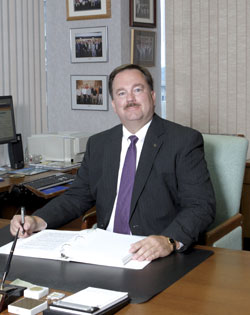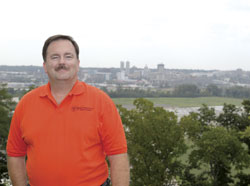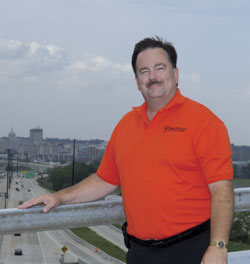Joe Crowe

Joe Crowe, the Deputy Director of Highways in Region Three of the Illinois Department of Transportation, began his career with IDOT at the Collinsville District in June 1984. He graduated from the University of Missouri-Rolla with a bachelor’s degree in civil engineering and has held several positions within IDOT as he worked his way up the ladder. In his current position as Deputy Director of Highways, Crowe is responsible for the operations and maintenance of all state highways in 19 counties, consisting of 3,162 miles of highways and 1,469 bridges. Combined, these highways support more than 19 million miles of travel daily. The region employs 700 full-time personnel and an additional 80 to 200 temporary employees to accomplish its mission.
Crowe is a Registered Professional Engineer in Illinois and Missouri and a graduate of the American Association of State Highway and Transportation Officials Management Institute at the University of Indiana. He is a member of the Illinois Association of Highway Engineers, the Illinois Society of Professional Engineers and the American Public Works Association. He currently serves on the Civil Engineering and Construction Advisory Board at Bradley University.
Tell us about your background, including schools you attended and your family.
I grew up in Fairview Heights, which is in southwestern Illinois and about 20 miles from St. Louis. I attended Belleville East High School, and after I graduated, my family moved to Sherman, Illinois. I attended Lincoln Land Community College before transferring to the University of Missouri-Rolla to study civil engineering. I graduated from UMR in May 1984.
My wife of nearly 22 years, Cheryl, is a registered nurse at OSF Saint Francis Medical Center, where she is the accreditation and licensure coordinator for the off-site ambulatory centers. We have two daughters: Danielle, who is almost 17 and a junior at Morton High School, and Alexa, who is eight and in third grade at Grundy School in Morton.
Who or what influenced you to become a civil engineer?
My father has always been the person I look up to and who has had the most influence on me. He grew up in the poor neighborhoods of North St. Louis and worked his way through engineering school. He worked very hard to have a successful career in both the public and private sectors, and provided my sisters and me with a wonderful and supportive home life. Although a civil engineer himself, he told me in high school to be a lawyer. It is one of the few times I did not listen to his advice, and I wound up following in his footsteps.
Describe the career path that led you to the Illinois Department of Transportation and the scope of your responsibilities as the Deputy Director of Highways for Region Three within IDOT.
After graduating from the University of Missouri-Rolla in 1984, I started working for the Illinois Department of Transportation in the Collinsville District. I worked in various positions, including operations engineer and program development engineer for 13½ years. I then went to the Effingham District as district engineer for about two years. After that, I became district engineer for the Peoria District in 1999, following the retirement of Dale Risinger. In 2004, I became the deputy director of highways, regional engineer, in which I oversee both the Peoria and Paris, Illinois, district offices.
How are IDOT projects funded in Illinois and Region Three? How are projects selected?
IDOT receives input from many sources about highway projects. In addition, we inspect our bridges and pavements on a routine basis, which gives us insight into the system rehabilitation needs across the state.
How does Illinois compare with other states in miles of highways, bridges, and other points of comparison?
Illinois is truly the crossroads of America. We have major east-west interstates—I-80, I-74, I-70 and I-64. We also have major north-south interstates—I-55, I-57 and I-39. According to the Federal Highway Administration, Illinois has 138,833 miles of highways and roads statewide, which ranks as the third largest system in the country. On a more local basis, the region I am in charge of has 3,162 miles of highways and 1,469 bridges, which supports over 19 million miles of travel each day. This is why transportation is so important in our state.
There hasn’t been a capital budget in Springfield for some time. How important is it for the state to put together a new capital budget to maintain our state’s infrastructure?
Investment in transportation infrastructure is critical to the economy of Illinois. It is one of the first things a company will look at when they consider moving to our state. In order to compete globally, we must continually invest resources in highways and other modes of transportation.
Do you think car and truck traffic will increase in the future?
Information we receive shows that traffic volumes will continue to increase for the foreseeable future. This is especially true as freight traffic is forecasted to double in the next twenty years, increasing the congestion we already experience on our nation’s highways. That is why operating the highway system at peak efficiency is important. In the Peoria area, we operate an intelligent transportation system on I-74, which allows us to monitor the traffic in our 24/7 communication center. This center is directly linked to the emergency responders so that incidents along I-74 can be taken care of quickly. We also attempt to avoid working during peak volume times on major highways in the area and are doing more work at night in efforts to lessen the congestion for motorists.
When the tragic bridge collapse occurred in Minnesota, you began comforting Illinoisans almost immediately by sending IDOT officials to do safety checks on area bridges. What is the state of Illinois’ bridges at this point?
IDOT has a very thorough and comprehensive bridge inspection program. We have highly-trained engineers and technicians in every district who inspect bridges every day. In addition, we have structural engineers in our central office in Springfield who are available to us. Our number one priority is the safety of the motoring public. If we have any concerns about a particular bridge, we will install a weight limit or close the bridge until repairs can be made.
Under former Governor Ryan’s Illinois First program, many dollars were allocated for infrastructure in central Illinois. Explain your work on that project and its economic impact on the region and state.
Illinois First was good for central Illinois. It gave us the funding to design and construct I-74 through Peoria and East Peoria, resurface I-474, rehabilitate the Cedar Street bridge and resurface I-155, as well as many other projects too numerous to mention here.
The I-74 upgrade was a monumental project for central Illinois. Upon reflection, the project appeared to meet budget and schedule, while disruptions to commuters seemed to be well-organized and not as bad as anticipated by many. What were some of the high and low points in the project for you?
Upgrade 74 was a career-type project for many of us at IDOT, but it was much larger than that. We worked with excellent engineering consultants, contractors and construction workers. We also worked with the community at large⎯going out to hundreds of groups to explain the project, utilizing the website developed for this particular project, as well as the up-to-date information on the toll-free hotline and the media advisories which were also used to help get the message out. We were confident in our team, but, of course, there were some skeptics. In the end, the plan worked out well, partly because of the great cooperation of the traveling public. That is why we consider it such a community success. Because the public was proud of the outcome, over 10,000 people came out to walk across the Murray Baker Bridge when it reopened.
What surprised you most about this project?
The overwhelming positive response we received from the public. Local drivers who traveled I-74 knew that something had to be done concerning the safety issues of crumbling bridges and roadways. Initially, they were concerned about how the construction would impact their daily commutes, but once the construction started and drivers learned of the travel options they had and could see the progress being made, they became excited about the project. This excitement was noticeable in the high attendance at the various public events surrounding the upgrade.
Do we have enough qualified construction workers and engineers to work on our highways? How many of the region’s workers were brought in to keep the I-74 project on time and within budget?
The information we receive from the various construction trades indicate that the average age of their members continues to go up, which shows that younger people are not entering these vocations. As current members reach retirement age, this could lead to labor shortages in several areas. We know that many of the trades are reaching out to various high schools in an attempt to get students interested in entering their apprentice programs.
On the I-74 project, we tracked the number, gender and ethnicity of the construction workers, but not their place of residence. We know that during peak construction periods, there were numerous out-of-region workers being supplied by the construction trade unions to many of the contractors working on this project.
On the engineering side, the national trend shows that fewer students are entering engineering schools. This, coupled with future increased demand, will create a shortage of qualified engineers in the future. Professional engineering groups, such as the National Society of Professional Engineers and the American Society of Civil Engineers, have programs in place which will go into junior high and high schools to get students excited about math and science classes so they have the educational background needed to pursue science and engineering degrees in college. It is vital to our company’s competition in the global economy that these programs succeed.
 What is the best way for business leaders to build awareness for highway needs with elected officials?
What is the best way for business leaders to build awareness for highway needs with elected officials?
We are very fortunate that our state and federal officials are very interested in and very supportive of transportation, and we brief them regularly on the status of various projects. We brief other groups as well, such as the Chambers of Commerce in Peoria, East Peoria, Morton, Washington, Pekin, Chillicothe and Macomb. We also have groups like the 34 Coalition, the US 67 Coalition, the 336 Coalition and the new Eastern Bypass Coalition which regularly meet with elected officials and the Illinois Secretary of Transportation.
What major projects in central Illinois are in the planning stage and on the drawing board for the future? What challenges does IDOT face?
The following area projects are in the planning or design stage at this time:
• IL 336 (Peoria to Macomb)
• US 34 (Cameron Road to US 67)
• US 67 (US 136 to IL 101)
• IL 29 (IL 6 to I-180)
• IL 40 (Cedar Hills to Mossville)
• IL 8 (Farm Creek to Business 24)
• US 24 (Banner to Kingston Mines)
• Eastern Bypass (IL 6 to I-74)
• Macomb Bypass (Northeast and Northwest of Macomb)
• I-74/I-155 Interchange (Morton)
• Allen/Alta Intersection (Peoria)
• IL 40/Pioneer Parkway Intersection (Peoria)
As you can see, this is quite a list. In addition to these, we continue to work on numerous bridge and resurfacing projects throughout the area. As always, the biggest challenge is securing the funds for these projects while continuing to maintain the existing highway system.
What will it take to make the central Illinois “Ring Road” a reality?
The “Ring Road,” or “Eastern Bypass” as it is now called, was put on hold in 1999 at the request of state and federal officials. However, community leaders kept working to get this project started again. When Congressman LaHood held his transportation symposiums before the present federal highway bill was passed, this project was consistently cited as a transportation need. After receiving this public input, Congressman LaHood worked to secure funding for a corridor study for this project. We now have a consultant on board, and the corridor study will soon proceed. Interested parties are encouraged to participate in future public meetings and contact the new private coalition for this project.
What are your thoughts on the attempt to bring Amtrak service to Peoria?
I do not have any direct involvement with the study to bring Amtrak service to Peoria. I do, however, take Amtrak out of Normal when I have meetings in Chicago. So as an Amtrak rider, I would enjoy the convenience of departing from and returning to Peoria.
What do you like to do in your spare time? What would you like our readers to know that has not been asked?
As you can imagine, having two very busy daughters does not leave Cheryl and me with a lot of spare time. Danielle is a pom-pom dancer at Morton High School, dances at a studio in Morton and runs track in the spring. Alexa takes dance lessons and plays soccer. We like to attend their events, and sometimes even have to split up to get to them all. When we do get some spare time, Cheryl and I enjoy going to Rivermen, Chiefs or Bradley basketball games. We also have season tickets to the Civic Center’s Broadway musical shows. That is Cheryl’s way of getting this engineer a little culture! IBI

